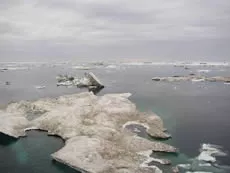Cryosphere glossary
the cumulative number of degree-days above 0 degrees Celsius, calculated by taking the average of the seasonal thawing indices for the three warmest summers in the most recent 30 years of record.
a slope failure in which the thawed or thawing portion of the active layer detaches from the underlying frozen material.
the temperature to which a given parcel of air must be cooled at constant pressure and constant water-vapor content in order for saturation to occur; when this temperature is below 0 degrees Celsius, it is called the frost point.
a type of precipitation composed of slowly falling, very small, unbranched crystals of ice which often seem to float in the air; it may fall from a high cloud or from a cloudless sky, it usually occurs under frosty weather conditions (under very low air temperatures).
measure of the ability of the soil to store electrical energy in the presence of an electrostatic field.
either of the two points on the earth's surface at which magnetic meridians converge; the horizontal component of the magnetic field of the earth becomes zero at this point; also called the magnetic pole.
An Arctic atmospheric pressure pattern characterized by high pressure centered over the northern Beaufort Sea and unusually low pressure centered over the Kara Sea. This pattern contributes to ice loss in summer, causing winds to blow ice away from the coast.
a cone-shaped formation of ice that is covered by dirt; a dirt cone is caused by a differential pattern of ablation between the dirt covered surface and bare ice.
ice that contains sediments stirred up and tangled in the ice as it grows.
Image

Terry Whitledge, National Oceanic and Atmospheric Administration/Department of Commerce
permafrost occurring in some areas beneath the exposed land surface throughout a geographic region where other areas are free of permafrost.
the major subdivision of a permafrost region in which permafrost occurs in some areas beneath the exposed land surface, whereas other areas are free of permafrost.
permafrost that is not in thermal equilibrium with the existing mean annual surface or sea-bottom temperature and the geothermal heat flux.
the thickness of sea ice extending below the water level. Draft and freeboard comprise total sea ice thickness.
a semipermanent mass of firn formed by drifted snow behind obstructions or in the ground; also called a catchment glacier or a snowdrift glacier.
displacement of a sea ice field from its place of origin under the effect of ocean currents and winds.